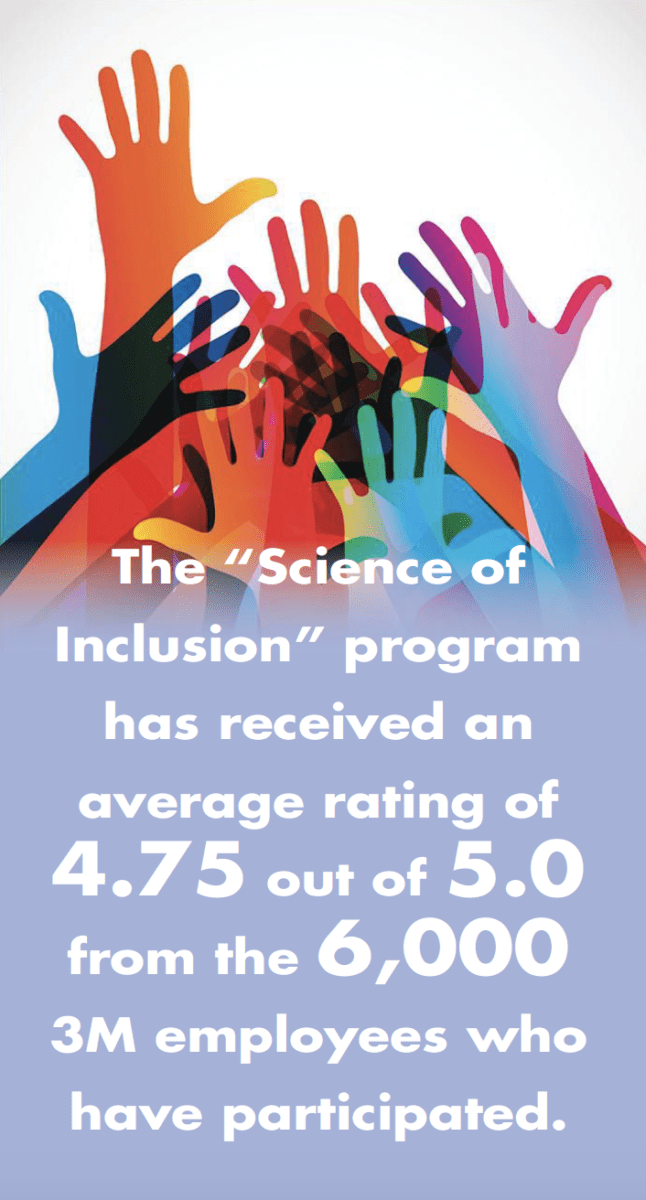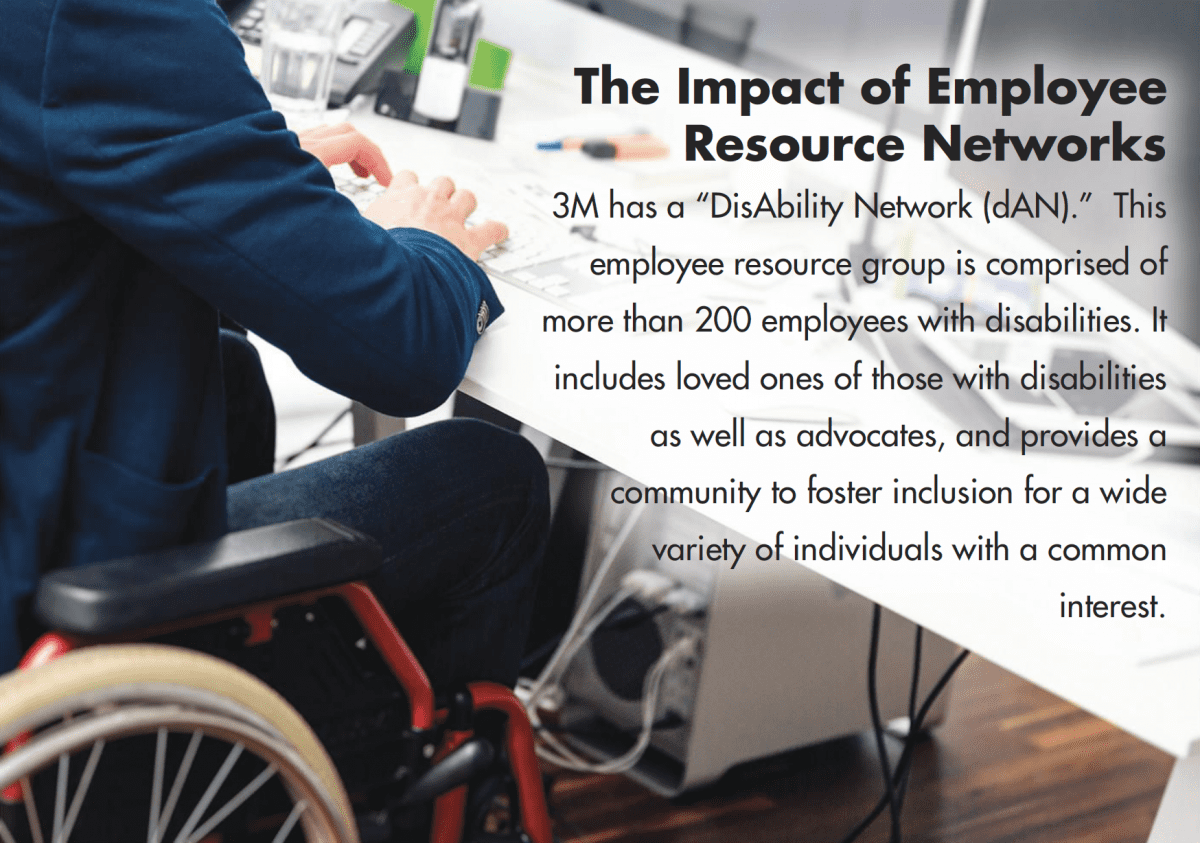3M’s D&I program is driven by the connection between inclusion and employee well-being.
By Ann Anaya
Diversity and inclusion go together -one cannot exist without the other. And they are distinctly different sides of the same coin.
To optimize performance, teams need to be diverse and include members with a wide array of backgrounds, experiences, abilities, and perspectives. But organizational teams also need to be inclusive and that means working in an environment where everyone has the freedom and comfort to fully engage and participate. Today’s employees seek to express their ideas and unique voices in ways that are appreciated and drive value.
3M is a science-based company. Science is even in the corporate tagline: “Science. Applied to Life.” And science has impacted the organization’s approach toward diversity and inclusion. 3M leaders have used the study of neuroscience to connect inclusive behaviors to well-being in the workforce. The result was the creation of “The Science of Inclusion” employee training program, which is rolling out regionally this year and slated for worldwide adoption in 2020.
The aim of “The Science of Inclusion” training is to apply the study of neuroscience -which deals with the structure and function of the nervous system and brain -as a guide to help 3M employees understand the connection between inclusion and employee well-being. It has been designed to take a methodical, fact-based approach to inclusion while reiterating and reinforcing its importance.
The Importance of Inclusion
 All individuals know what it feels like to be excluded from a team or a group. In fact, some studies have revealed that people experience social exclusion in much the same way as they experience physical pain. As a result, exclusion can prompt a feeling of defeat among those impacted.
All individuals know what it feels like to be excluded from a team or a group. In fact, some studies have revealed that people experience social exclusion in much the same way as they experience physical pain. As a result, exclusion can prompt a feeling of defeat among those impacted.
Conversely, to feel included is empowering. Empirical evidence shows that positive emotions and a sense of connectedness to others -or inclusion -can enhance physical health and workforce well-being. The training goes beyond these intrinsic truths, revealing the physiological and neurological impact of inclusive behaviors in the workplace. Importantly, it scientifically proves the power of inclusion.
The “Science of Inclusion” program has received an average rating of 4.75 out of 5.0 from the 6,000 3M employees who have participated. This feedback shows that when done well, a culture of inclusion enables one of the most important aspects of a productive workplace culture -psychosocial safety.
A Safe Workplace Is a Productive Workplace
Prioritizing psychosocial safety creates an environment that allows everyone to thrive and feel comfortable showing their authentic selves. Its existence is central to a working environment that is both comfortable to employees and highly productive.
Current research indicates the power of a diverse and inclusive workplace, showing a strong association between employee well-being and productivity. For example, researchers in New Zealand have drawn a correlation between feeling appreciated by one’s colleagues and experiencing a sense of thriving, which is described as a high degree of emotional and psychosocial well-being. The study found that workers who feel appreciated by colleagues are 29 percent more likely to “flourish” on the job.
Many organizations are fostering an environment of psychosocial safety by encouraging employees to explore their interests and cultural identities with colleagues. Employee resource networks (ERNs) or employee resource groups (ERGs) can nurture leadership skills and collaboration across cultures, lifestyles, and genders. They engage and help retain diverse talent while providing customer insights that can expand visibility and sales.
AT&T has earned global recognition for its ERNs and ERGs, with a key reason being that they are open in nature. AT&T has thrived because these groups are truly inclusive, enabling participation from anyone who is interested. From “The Women of AT&T” to “Parents@Work,” these AT&T groups stimulate cross-collaboration and engagement.
3M has also seen the positive impact of ERNs. For instance, its “DisAbility Network (dAN)” is comprised of more than 200 employees with disabilities and also includes loved ones of and advocates for those with disabilities. It’s a perfect example of how such a group can foster inclusion for a wide variety of individuals with a common interest.

The facts are clear: A diverse, global, and empowered workforce helps companies relate more closely to customers, suppliers, and channel partners around the world. “The Science of Inclusion” training program encourages employees to be A.C.T.I.V.E.:
- Ask to involve colleagues from a variety of backgrounds, abilities, and ages in decision-making processes.
- Celebrate and respect differences to foster a sense of uniqueness among colleagues.
- Treat colleagues as valued teammates to support a sense of belonging.
- Integrate what you learn about inclusion into daily interactions to strengthen the culture of inclusion.
- Verify that professional decisions do not inadvertently exclude a social group.
- Encourage colleagues of all backgrounds, age groups, and abilities to contribute their unique perspectives.
Being mindful of inclusivity reaps real rewards for organizations of all sizes and in all industries. By broadening the ability to collaborate, inclusive organizations are well-prepared to innovate and prosper.
And for those organizations that have been slow to the inclusivity party, now is the time to move from awareness building to action by setting goals, measuring progress, being transparent with data, and importantly, holding leaders accountable.
Call it the art -and science -of inclusion.
Ann Anaya is chief diversity officer for 3M.














